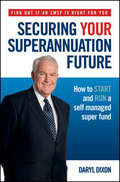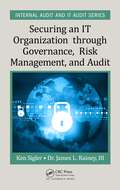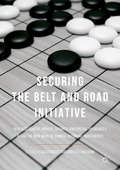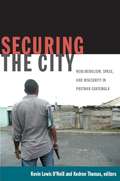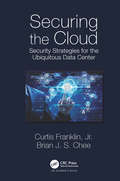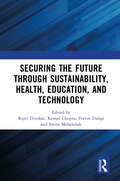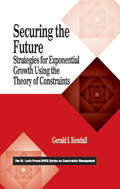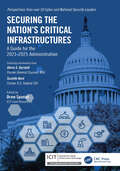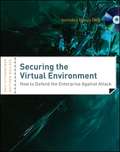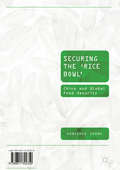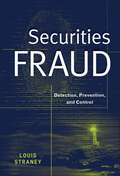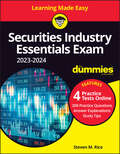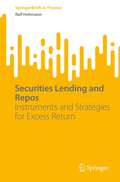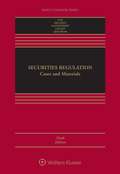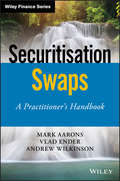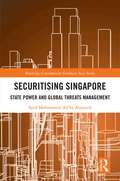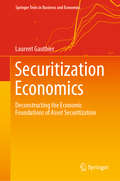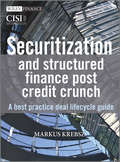- Table View
- List View
Securing Your Organization's Future: A Complete Guide to Fundraising Strategies
by Michael SeltzerA step-by-step approach to creating and sustaining a network of funding sources through a discussion of: Major organizational tasks to address before applying for funding How to determine the best mix of funding resources for the long term The use of special events, direct mail, the telephone, planned giving, the Internet, and earned and venture income to obtain support from individual donors How to secure funding support from institutional sources such as foundations, corporations and businesses, government, religious institutions, and others A blueprint for designing and implementing fundraising strategies How to capitalize on the uniqueness of your organization to secure funding
Securing Your Superannuation Future
by Daryl DixonFind Out if an SMSF is Right for You Are you thinking about setting up a self managed superannuation fund but unsure where to start? Are you worried that you're not maximising all the benefits an SMSF offers? In Securing Your Superannuation Future, Daryl Dixon offers practical, easy-to-understand tools and strategies to help you set up and run your own super fund. More Australians than ever are deciding to take control of their super, and Daryl's insights go beyond the standard requirements for running an SMSF. He reveals many tax-saving tips and practical steps to work through important decisions such as: Do you need professional assistance to run your fund? Who should be the trustees and members of your SMSF? What steps should you take to build your super in a tax-effective way? How do you construct your SMSF investment portfolio? When and how should you access your super? How can you maximise the amount of super you pass on to your beneficiaries?
Securing an IT Organization through Governance, Risk Management, and Audit (ISSN)
by Ken E. Sigler James L. Rainey IIIThis book introduces two internationally recognized bodies of knowledge: COBIT 5 from a cybersecurity perspective and the NIST Framework for Improving Critical Infrastructure Cybersecurity (CSF). Emphasizing the processes directly related to governance, risk management, and audit, the book maps the CSF steps and activities to the methods defined in COBIT 5, extending the CSF objectives with practical and measurable activities that leverage operational risk understanding in a business context. This allows the ICT organization to convert high-level enterprise goals into manageable, specific goals rather than unintegrated checklist models.
Securing the Belt and Road Initiative
by Alessandro Arduino Xue GongThis collection explores the expansion of Chinese outbound investments, aimed to sustain the increased need for natural resources, and how they have amplified the magnitude of a possible international crisis that the People's Republic of China may face in the near future by bringing together the views of a wide range of scholars. President Xi's Belt and Road initiative (BRI), aimed to promote economic development and exchanges with China for over 60 countries, necessitates a wide range of security procedures. While the threats to Chinese enterprises and Chinese workers based on foreign soil are poised to increase, there is an urgent need to develop new guidelines for risk assessment, special insurance and crisis management. While the Chinese State Owned Enterprises are expanding their international reach capabilities, they still do not have the capacity to assure adequate security. In such a climate, this collection will be of profound value to policy makers, those working in the financial sector, and academics.
Securing the City: Neoliberalism, Space, and Insecurity in Postwar Guatemala
by Kevin Lewis O'Neil Kedron ThomasUnprecedented crime rates have made Guatemala City one of the most dangerous cities in the world. Following a peace process that ended Central America's longest and bloodiest civil war and impelled the transition from a state-centric economy to the global free market, Guatemala's neoliberal moment is now strikingly evident in the practices and politics of security. Postwar violence has not prompted public debates about the conditions that permit transnational gangs, drug cartels, and organized crime to thrive. Instead, the dominant reaction to crime has been the cultural promulgation of fear and the privatization of what would otherwise be the state's responsibility to secure the city. This collection of essays, the first comparative study of urban Guatemala, explores these neoliberal efforts at security. Contributing to the anthropology of space and urban studies, this book brings together anthropologists and historians to examine how postwar violence and responses to it are reconfiguring urban space, transforming the relationship between city and country, and exacerbating deeply rooted structures of inequality and ethnic discrimination. Contributors. Peter Benson, Manuela Camus, Avery Dickins de Girn, Edward F. Fischer, Deborah Levenson, Thomas Offit, Kevin Lewis O'Neill, Kedron Thomas, Rodrigo Jos Vliz
Securing the Cloud: Security Strategies for the Ubiquitous Data Center
by Brian Chee Curtis Franklin Jr.This book provides solutions for securing important data stored in something as nebulous sounding as a cloud. A primer on the concepts behind security and the cloud, it explains where and how to store data and what should be avoided at all costs. It presents the views and insight of the leading experts on the state of cloud computing security and its future. It also provides no-nonsense info on cloud security technologies and models. Securing the Cloud: Security Strategies for the Ubiquitous Data Center takes the position that cloud security is an extension of recognized, established security principles into cloud-based deployments. It explores how those principles can be put into practice to protect cloud-based infrastructure and data, traditional infrastructure, and hybrid architectures combining cloud and on-premises infrastructure. Cloud computing is evolving so rapidly that regulations and technology have not necessarily been able to keep pace. IT professionals are frequently left to force fit pre-existing solutions onto new infrastructure and architectures for which they may be very poor fits. This book looks at how those "square peg/round hole" solutions are implemented and explains ways in which the pegs, the holes, or both may be adjusted for a more perfect fit.
Securing the Future through Sustainability, Health, Education, and Technology
by Rajiv Divekar Komal Chopra Smita Mehendale Pravin DangeOrganized on 13th–15th December 2023, The 14th Annual International Research Conference of the Symbiosis Institute of Management Studies, (SIMSARC 2023) is based on the theme “Securing the Future through Sustainability, Health, Education and Technology”. It focuses on the need for a holistic approach to address the present challenges of the world while envisioning a resilient and prosperous tomorrow. It discusses the interconnections between Sustainability, Health, Education and Technology in fostering long-term well-being and addresses challenges and future opportunities.
Securing the Future: Globally Preempting Competitors
by Gary Hamel C. K. PrahaladWhen several companies are tracking the same broad opportunity and striving to build roughly similar competencies, the issue is how to maximize one's share of worldwide revenues when the market finally takes off. This chapter discusses the keys to global preemption, the final milestone on the road to competing for the future.
Securing the Future: Strategies for Exponential Growth Using the Theory of Constraints (The CRC Press Series on Constraints Management)
by Gerald I. KendallToday's managers encounter tremendous resistance in getting others to buy-in to change. The ongoing rounds of downsizing and upheaval have taken their toll, leaving a legacy of skepticism. Therefore, managers must not only have ideas, but must be experts at "selling" the correct answers, information, and measurements to address issues of change.
Securing the Nation’s Critical Infrastructures: A Guide for the 2021-2025 Administration
by Drew SpanielSecuring the Nation’s Critical Infrastructures: A Guide for the 2021–2025 Administration is intended to help the United States Executive administration, legislators, and critical infrastructure decision-makers prioritize cybersecurity, combat emerging threats, craft meaningful policy, embrace modernization, and critically evaluate nascent technologies. The book is divided into 18 chapters that are focused on the critical infrastructure sectors identified in the 2013 National Infrastructure Protection Plan (NIPP), election security, and the security of local and state government. Each chapter features viewpoints from an assortment of former government leaders, C-level executives, academics, and other cybersecurity thought leaders. Major cybersecurity incidents involving public sector systems occur with jarringly frequency; however, instead of rising in vigilant alarm against the threats posed to our vital systems, the nation has become desensitized and demoralized. This publication was developed to deconstruct the normalization of cybersecurity inadequacies in our critical infrastructures and to make the challenge of improving our national security posture less daunting and more manageable. To capture a holistic and comprehensive outlook on each critical infrastructure, each chapter includes a foreword that introduces the sector and perspective essays from one or more reputable thought-leaders in that space, on topics such as: • The State of the Sector (challenges, threats, etc.) • Emerging Areas for Innovation • Recommendations for the Future (2021–2025) Cybersecurity Landscape ABOUT ICIT The Institute for Critical Infrastructure Technology (ICIT) is the nation’s leading 501(c)3 cybersecurity think tank providing objective, nonpartisan research, advisory, and education to legislative, commercial, and public-sector stakeholders. Its mission is to cultivate a cybersecurity renaissance that will improve the resiliency of our Nation’s 16 critical infrastructure sectors, defend our democratic institutions, and empower generations of cybersecurity leaders. ICIT programs, research, and initiatives support cybersecurity leaders and practitioners across all 16 critical infrastructure sectors and can be leveraged by anyone seeking to better understand cyber risk including policymakers, academia, and businesses of all sizes that are impacted by digital threats.
Securing the Peace: The Durable Settlement of Civil Wars
by Monica Duffy ToftTimely and pathbreaking, Securing the Peace is the first book to explore the complete spectrum of civil war terminations, including negotiated settlements, military victories by governments and rebels, and stalemates and ceasefires. Examining the outcomes of all civil war terminations since 1940, Monica Toft develops a general theory of postwar stability, showing how third-party guarantees may not be the best option. She demonstrates that thorough security-sector reform plays a critical role in establishing peace over the long term. Much of the thinking in this area has centered on third parties presiding over the maintenance of negotiated settlements, but the problem with this focus is that fewer than a quarter of recent civil wars have ended this way. Furthermore, these settlements have been precarious, often resulting in a recurrence of war. Toft finds that military victory, especially victory by rebels, lends itself to a more durable peace. She argues for the importance of the security sector--the police and military--and explains that victories are more stable when governments can maintain order. Toft presents statistical evaluations and in-depth case studies that include El Salvador, Sudan, and Uganda to reveal that where the security sector remains robust, stability and democracy are likely to follow. An original and thoughtful reassessment of civil war terminations, Securing the Peace will interest all those concerned about resolving our world's most pressing conflicts.
Securing the Virtual Environment: How to Defend the Enterprise Against Attack
by Davi Ottenheimer Matthew WallaceA step-by-step guide to identifying and defending against attacks on the virtual environment As more and more data is moved into virtual environments the need to secure them becomes increasingly important. Useful for service providers as well as enterprise and small business IT professionals the book offers a broad look across virtualization used in various industries as well as a narrow view of vulnerabilities unique to virtual environments. A companion DVD is included with recipes and testing scripts. Examines the difference in a virtual model versus traditional computing models and the appropriate technology and procedures to defend it from attack Dissects and exposes attacks targeted at the virtual environment and the steps necessary for defense Covers information security in virtual environments: building a virtual attack lab, finding leaks, getting a side-channel, denying or compromising services, abusing the hypervisor, forcing an interception, and spreading infestations Accompanying DVD includes hands-on examples and code This how-to guide arms IT managers, vendors, and architects of virtual environments with the tools they need to protect against common threats.
Securing the ‘Rice Bowl’: China and Global Food Security
by Hongzhou ZhangThis book offers a snappy but comprehensive investigation of how the resource needs of today could become the resource conflicts of tomorrow. As the most populous country in the world, the security of China’s “rice bowl” is not only a top political priority for China’s policymakers but increasingly a critical global concern as the country emerges as a leading food importer and a major player in outward agricultural investment. This book sheds light on China’s efforts, both at home and abroad, to safeguard its food security and how these efforts will affect global food systems. This book will be of interest to industry analysts, institutional investors, and scholars of China's global rise.
Securities Fraud
by Louis L. StraneyThe first complete, expert guide to securities and investment fraud Filled with expert guidance for detection and prevention of all kinds of securities fraud and investment misconduct, Securities Fraud helps you identify red flags of fraud and offers practical ways to detect and prevent it. Written by a Wall Street professional with three decades of experience spanning the most critical period of our financial markets This book challenges classic fraud theories, describing how to dismantle information silos that permit fraudsters to conceal their activities. Begins with an overview of the evolution of securities regulation and the impact of securities fraud Offers real cases and examples which illustrate recurring themes and red flags Provides the first guide of its kind to offer a complete look at the various kinds of securities fraud and investment misconduct Securities Fraud is the essential guide you need for a bird's-eye view of fraud that may be taking place even now within your own organization and with your portfolio.
Securities Industry Essentials Exam 2023-2024 For Dummies with Online Practice
by Steven M. RiceKnock out the SIE on your first try Securities Industry Essentials Exam 2023-2024 For Dummies is this year’s definitive study guide for prospective securities industry professionals—that means you! FINRA administers this notoriously difficult exam as a prerequisite to the Series 7 and other series level exams, so you’ll need to know your stuff in order to get where you're going. Securities professionals are in high demand, and this study guide can help you become one of them. You'll have access to two complete practice tests, plus two more online! With this trusted Dummies guide, you have everything you need to get a high score on the SIE. Hundreds of practice questions help you internalize the must-know info, and we explain the content in a way you can easily grasp. You’ll go into your securities exam feeling, well, secure! Review all the content tested on the Security Industry Professionals exam Get prepared with two in-book practice tests and two more online tests Launch your dream career in the growing field of securities, commodities, and financial services Take an in-depth look at how the SIE exam is structured and how you can improve your score Let employers see how well you know your stuff—this friendly study guide is your ticket to passing the SIE.
Securities Law and Private Financing
by Michael J. Roberts Howard H. StevensonDescribes the issues an entrepreneur faces in the process of raising private funds, and the securities laws which impact the process. Based in part on a note by R.E. Floor of the law firm of Goodwin, Procter & Hoar.
Securities Law and Public Offerings
by Michael J. Roberts Howard H. StevensonDescribes the relevant securities laws which pertain to the public offering of securities, as well as the business issues and process of a public offering.
Securities Lending After the Financial Crisis
by Robert C. Pozen Gayle HameisterIn April 2009, Wendy Jefferson had just returned to her office following a whirlwind day of meetings with her newest client, Star Advisor. Jefferson, a financial services consultant, was eager to dig into the information provided to her and her team about the Star mutual funds and the income the funds earned from securities lending. Securities lending involved temporarily transferring securities from mutual funds managed by Star Advisor to short sellers and other investors. Income from these loans had been a small but secure component of Star mutual fund returns for decades.
Securities Lending and Repos: Instruments and Strategies for Excess Return (SpringerBriefs in Finance)
by Ralf HohmannThe aim of this book is to present different manifestations and conventional transactions with securities lending and repos. Securities lending as a way of short selling is not only suitable for hedging cash market positions, it is also an essential prerequisite for valuing options on the futures market. Their valuation according to the option price theory is theoretically not possible without securities lending. If, at the same time, no derivatives are traded on the market as a substitute, the valuation of a portfolio of cash and futures market positions is difficult to practice. This is unacceptable for the annual financial statements of banks, insurance companies and other capital collection agencies. With securities lending and repos, returns can be achieved with selected strategies that are above the risk-free interest rate for corresponding maturities. Market participants use differential arbitrage and compensatory arbitrage with different interest rates and premiums on the market to achieve excess returns. This is not pure short selling. Interest rates and premiums in the market should theoretically strive towards equilibrium through these transactions. Market participants thus promote market efficiency, and the resulting changes in premiums and interest rates benefit all market participants. This book targets finance professionals working in capital markets and wanting to expand their knowledge of the topic.
Securities Regulation: Cases and Materials (Aspen Casebook Series)
by James D. Cox Robert W. Hillman Donald C. Langevoort Ann M. Lipton William K. SjostromThis book contains a very teachable mix of problems, cases, and textual material, encouraging students to build their knowledge base by being active problem-solvers. Always forward-thinking, stressing current developments and controversies, the book is also highly modular, so that professors can easily pick and choose how to structure their courses without being locked into any given progression. New to the Ninth Edition: Coverage of “cryptocurrencies” and coin offerings, Commentary on market developments such as indexing and algorithmic trading, A tighter set of problems and materials on gun-jumping under Section 5, The SEC’s latest reforms of Regulation D and the intrastate offering exemption, Spotify and the trend toward direct listings as a way of going public, Coverage of Supreme Court decisions from the last three years, including Lorenzo, Salman, Cyan, Lucia, and Kokesh, as well as important lower court cases, The SEC broker-dealer proposal (and perhaps adoption) of Regulation Best Interest. Professors and students will benefit from: The book’s highly modular organization, enabling different teaching formats and coverage, Concise notes that introduce the reader to both theory and real-life practice issues. "Securities Regulation casebook for law students"- Provided by publisher.
Securities Trading: Front, Middle, and Back Office
by Francois Brochet Rakeen MabudThis note explains the basic structure of the trading floor in a typical financial institution and how the front, middle and back offices interact to ensure a functioning trading system.
Securitisation Swaps: A Practitioner's Handbook (Wiley Finance)
by Andrew Wilkinson Mark Aarons Vlad EnderDevelop the skillset essential to successful securitisation swaps management Securitisation Swaps is a complete practitioner’s guide to this unique and complex class of derivatives. This detailed examination follows the entire life cycle of securitisation swaps to give quants, structurers, traders, originators, issuers and lawyers a common reference for understanding their shared objective. Broad in scope to provide a common-ground perspective — yet detailed enough to promote full understanding — the discussion takes a distinctly cross-disciplinary approach that encompasses the multi-faceted knowledge base required to successfully execute these complex trades. Despite the fact that the size of the market is trillions of dollars in notional principal, securitisation swaps have thus far been neglected in both academic and practitioner literature. The numerous stakeholders that work together on these complex deals will all greatly benefit from a thorough understanding of their underlying risks and gain deep insight into the perspectives of each stakeholder. This invaluable guide provides multi-disciplinary insight that allows practitioners to: Manage securitisation swaps more effectively, from pre-trade structuring and modelling to post-trade risk management and accounting Understand the elements of securitisation and covered bonds, and how swaps mitigate risk in these types of transactions Explore how securitisation swaps differ from other derivatives and delve into their three specific risk factors — swap prepayment risk, swap extension risk and downgrade risk Learn practical methods and strategies of risk management, accounting, pricing and transaction execution When securitisation trades go wrong, they become front-page news — but when each participant understands accurate modelling, risk mitigation, optimal structuring, costs, pricing, commercial backgrounds and other integral practices, they are able to work together to achieve a shared objective. Securitisation Swaps provides the essential knowledge that streamlines and safeguards these important trades.
Securitising Singapore: State Power and Global Threats Management (Routledge Contemporary Southeast Asia Series)
by Syed Mohammed AljuniedAljunied examines how the Singaporean government developed a comprehensive state–society strategic relationship by ‘securitising’ vital policy areas because of Singapore’s vulnerability as a global city state. In the twenty-first century, the Singaporean government has strategically renewed an existing form of authoritarian rule by ‘militarising’ national security governance. The main objective is to widen and deepen state power. Senior military-trained civilian political leaders and bureaucrats use military personnel, command and control, terminology and strategy of war to deal with non-traditional security challenges leading to the state’s further domination over civil liberty and civil society. Aljunied analyses the information and communication, health and climate–environment sectors. The case studies highlight the way the Singaporean government has used varying forms of political engagement, surveillance and legislation to limit civil liberty and inhibit the development of civil society. This book is a valuable resource for researchers and students of Singapore Studies as well as for the readers of Security Studies with an interest in the global–local nexus in a small state context. It is a pioneering scholarly study on the national security framework and the use of non-traditional security discourse to strengthen state power and social stability at the expense of political liberalism.
Securitization Economics: Deconstructing the Economic Foundations of Asset Securitization (Springer Texts in Business and Economics)
by Laurent GauthierSecuritization is widely used around the world, and structured products are one of the largest fixed-income asset classes. This textbook guides readers through the complexity of this financial technique and first introduces them to the mechanics of securitization and makes the key concepts, techniques and logic of this field accessible for teachers and students alike. Further, the textbook presents a systematic economic analysis of securitization, asking and answering why it exists, how it works, why it has failed, how complex structures operate, why they are so complex, and many other related questions. The author offers a unique approach, and combines detailed discussions of theoretical economics models with advanced empirical research in order to confront them to the perspective of an experienced practitioner in this market.
Securitization and Structured Finance Post Credit Crunch
by Markus KrebszIn this book, you will be introduced to generic best practice principles for a post credit crunch market. First, the book takes a closer look at the reasons why the market froze during the 2007 to 2009 credit crisis. Then you will learn how to use the principles explained here in your generic deal's typical life cycle stages. Throughout, each stage is discussed in detail, from strategy and feasibility, pre-close, at close, and post close. The final section of the book contains a toolbox of references, tables, dictionaries, and resources.

